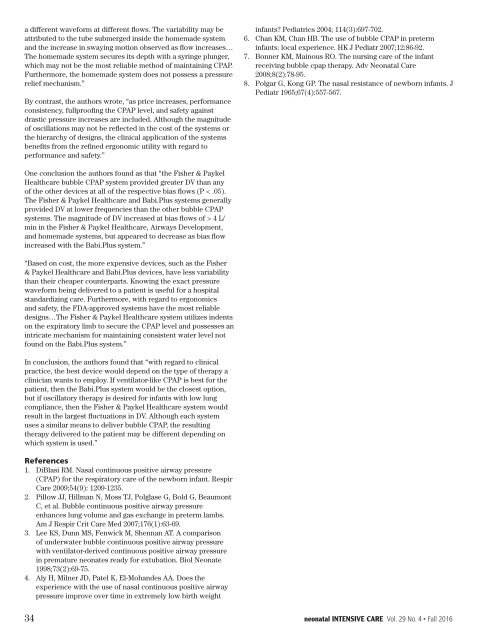INTENSIVE CARE
8dI2AMDUa
8dI2AMDUa
You also want an ePaper? Increase the reach of your titles
YUMPU automatically turns print PDFs into web optimized ePapers that Google loves.
a different waveform at different flows. The variability may be<br />
attributed to the tube submerged inside the homemade system<br />
and the increase in swaying motion observed as flow increases…<br />
The homemade system secures its depth with a syringe plunger,<br />
which may not be the most reliable method of maintaining CPAP.<br />
Furthermore, the homemade system does not possess a pressure<br />
relief mechanism.”<br />
By contrast, the authors wrote, “as price increases, performance<br />
consistency, fullproofing the CPAP level, and safety against<br />
drastic pressure increases are included. Although the magnitude<br />
of oscillations may not be reflected in the cost of the systems or<br />
the hierarchy of designs, the clinical application of the systems<br />
benefits from the refined ergonomic utility with regard to<br />
performance and safety.”<br />
infants? Pediatrics 2004; 114(3):697-702.<br />
6. Chan KM, Chan HB. The use of bubble CPAP in preterm<br />
infants: local experience. HK J Pediatr 2007;12:86-92.<br />
7. Bonner KM, Mainous RO. The nursing care of the infant<br />
receiving bubble cpap therapy. Adv Neonatal Care<br />
2008;8(2):78-95.<br />
8. Polgar G, Kong GP. The nasal resistance of newborn infants. J<br />
Pediatr 1965;67(4):557-567.<br />
One conclusion the authors found as that “the Fisher & Paykel<br />
Healthcare bubble CPAP system provided greater DV than any<br />
of the other devices at all of the respective bias flows (P < .05).<br />
The Fisher & Paykel Healthcare and Babi.Plus systems generally<br />
provided DV at lower frequencies than the other bubble CPAP<br />
systems. The magnitude of DV increased at bias flows of > 4 L/<br />
min in the Fisher & Paykel Healthcare, Airways Development,<br />
and homemade systems, but appeared to decrease as bias flow<br />
increased with the Babi.Plus system.”<br />
“Based on cost, the more expensive devices, such as the Fisher<br />
& Paykel Healthcare and Babi.Plus devices, have less variability<br />
than their cheaper counterparts. Knowing the exact pressure<br />
waveform being delivered to a patient is useful for a hospital<br />
standardizing care. Furthermore, with regard to ergonomics<br />
and safety, the FDA-approved systems have the most reliable<br />
designs…The Fisher & Paykel Healthcare system utilizes indents<br />
on the expiratory limb to secure the CPAP level and possesses an<br />
intricate mechanism for maintaining consistent water level not<br />
found on the Babi.Plus system.”<br />
In conclusion, the authors found that “with regard to clinical<br />
practice, the best device would depend on the type of therapy a<br />
clinician wants to employ. If ventilator-like CPAP is best for the<br />
patient, then the Babi.Plus system would be the closest option,<br />
but if oscillatory therapy is desired for infants with low lung<br />
compliance, then the Fisher & Paykel Healthcare system would<br />
result in the largest fluctuations in DV. Although each system<br />
uses a similar means to deliver bubble CPAP, the resulting<br />
therapy delivered to the patient may be different depending on<br />
which system is used.”<br />
References<br />
1. DiBlasi RM. Nasal continuous positive airway pressure<br />
(CPAP) for the respiratory care of the newborn infant. Respir<br />
Care 2009;54(9): 1209-1235.<br />
2. Pillow JJ, Hillman N, Moss TJ, Polglase G, Bold G, Beaumont<br />
C, et al. Bubble continuous positive airway pressure<br />
enhances lung volume and gas exchange in preterm lambs.<br />
Am J Respir Crit Care Med 2007;176(1):63-69.<br />
3. Lee KS, Dunn MS, Fenwick M, Shennan AT. A comparison<br />
of underwater bubble continuous positive airway pressure<br />
with ventilator-derived continuous positive airway pressure<br />
in premature neonates ready for extubation. Biol Neonate<br />
1998;73(2):69-75.<br />
4. Aly H, Milner JD, Patel K, El-Mohandes AA. Does the<br />
experience with the use of nasal continuous positive airway<br />
pressure improve over time in extremely low birth weight<br />
34 neonatal <strong>INTENSIVE</strong> <strong>CARE</strong> Vol. 29 No. 4 • Fall 2016


